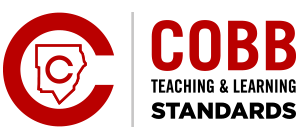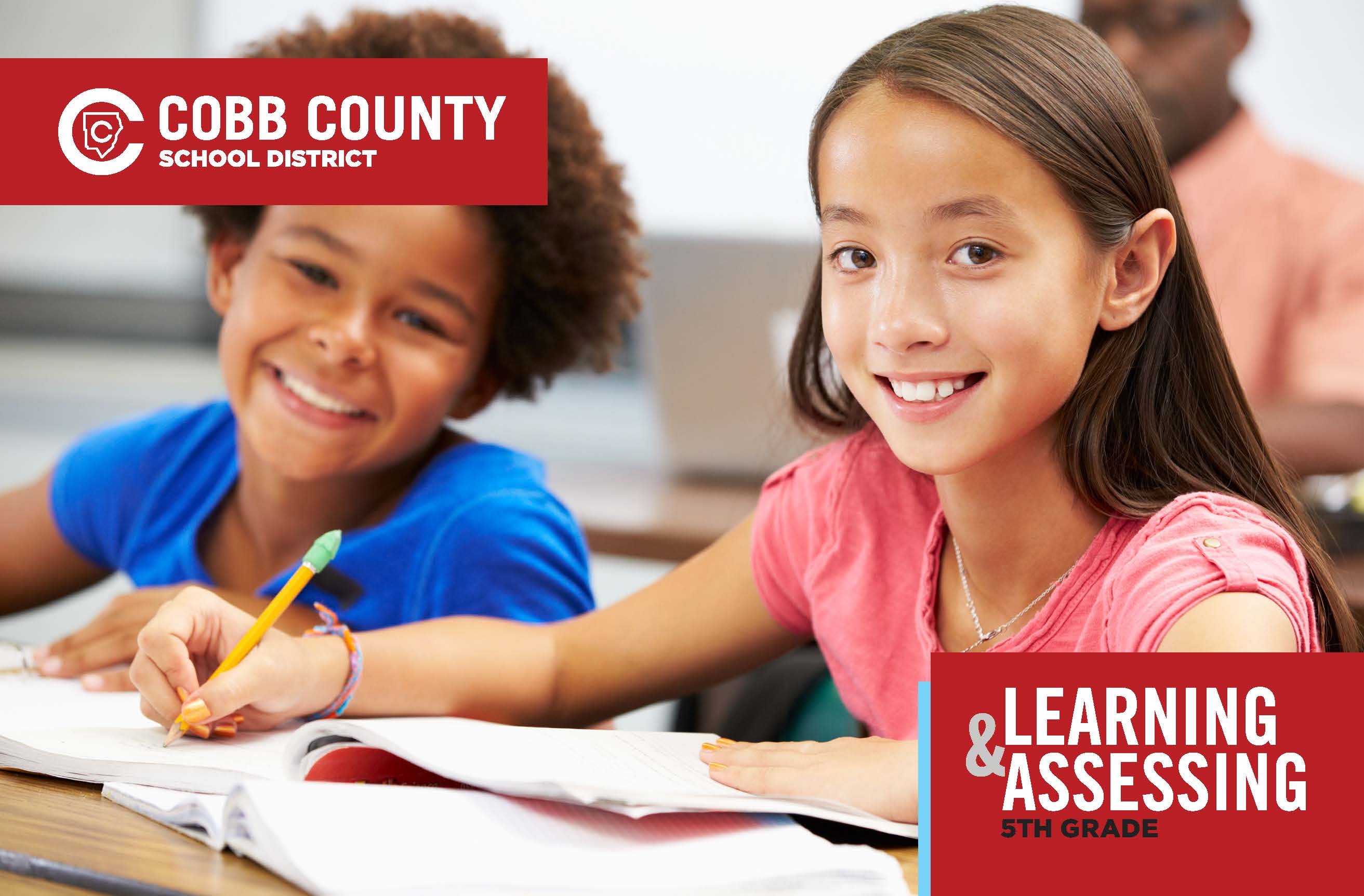5th Grade Learning

What Do Students Learn In 5th Grade?
5th GRADE LEARNING :
The Cobb County School District is committed to providing your child an academic experience that will develop his or her knowledge and skills at every grade level and to ensuring a strong foundation is established for your child to reach his or her greatest potential.
Our teaching is aligned with content standards and our teachers bring those standards to life for your child through various strategies designed to meet your child’s learning strengths and needs.
In Cobb County classrooms, students are immersed every day in learning experiences based on exploration, problem-solving, and critical thinking in all content areas, including the core areas of English Language Arts, Mathematics, Social Studies, and Science; and in specialized academic content including Health, Music, Physical Education, Technology, Visual Arts, and World Languages*. Excellence in teaching guides your child’s educational experience from Kindergarten to graduation and into life.
*Programming available varies at local schools.
ENGLISH LANGUAGE ARTS:
In grades K through 5, students build a strong foundation in reading, writing, speaking, and listening through daily engagement with meaningful, structured literacy experiences. Across these early years, students develop the skills and strategies needed to comprehend and analyze grade-level texts of appropriate complexity. As they grow, they learn to anchor their thinking in evidence from both literary and informational texts, supporting their ideas with increasing clarity and specificity.
Students explore a wide range of genres and text types, developing the ability to identify main ideas and themes, analyze characters and plot, and understand how word choice and text structure influence meaning. They begin to recognize how authors use scenes, chapters, and narration to organize stories, and how aesthetic elements contribute to a text’s impact. Their writing also becomes more purposeful and organized as they express ideas across various genres, using the full writing process and applying conventions of grammar, spelling, and punctuation.
By the end of fifth grade, students are prepared to read with fluency and insight, communicate their thinking clearly, and respond to texts with independence and critical thought. Grade-level text complexity is a key component of instruction, with teachers guiding students to engage with increasingly challenging material through supported practice and meaningful tasks.
MATHEMATICS:
In Grade 5, instructional time should regularly incorporate the 8 Mathematical Practices, the Statistical Reasoning Framework, and the Mathematical Modeling Framework through four big ideas of content: (1) numerical reasoning, (2) measurement and data (statistical) reasoning, (3) patterning and algebraic reasoning, and (4) geometric and spatial reasoning. Students are expected to develop place value understanding, part-whole strategies for addition and subtraction of whole numbers, fractions, and decimals, multiplication, and division of whole numbers and fractions, reasoning with patterns and algebra, reasoning with measurement of time and objects, geometric measurement strategies for determining volume, an understanding of the geometric properties of shapes, and data and statistical reasoning methods.
SCIENCE:
Fifth grade science focuses on hands-on, student-centered exploration of the world, with Earth, Life, and Physical Science woven throughout the year. Students deepen their understanding of core concepts while developing key scientific skills. They investigate topics such as how Earth's surface features are shaped by constructive and destructive forces, explore cells and microbes, and study the classification of living organisms. Additionally, students examine chemical changes and the principles of electricity and magnetism. Technology plays an integral role in their learning, as they use digital tools to display data in graphs and charts, collaborate on projects, and conduct independent research.
SOCIAL STUDIES:
In fifth grade, students are in the final year of a three-year study of United States history in which all four strands (history, geography, civics/government, and economics) are integrated. Students begin the year learning about the growth of 19th century industry and innovation in the United States and culminate the study with the events and impact of September 11, 2001. The geography strand emphasizes the influence of geography on U.S. history during these same time periods. In the civics/government strand, students learn about the rights of citizens contained within the Constitution, and how changes have been made over time to the Constitution to protect the rights of citizens. In the economic strand, students explore the ways consumers and producers have interacted in the American economy.
SPECIALS:
Observation and technical skills are supported through the creative arts at 5th grade. In Visual Arts, students plan for the creation of expressive artwork, use diverse media and techniques and engage in art critique and aesthetic exploration. In Music, students increase their individual skills by applying musical concepts to many genres and styles of music. Students focus on expressive qualities (phrasing, dynamics, and interpretation) in preparation for continued musical instruction in the middle grades and enjoyment for life. In Health, personal health is the focus. In PE, movement that emphasizes pattern and sequence is explored. Goal-setting and fitness assessment supports learning.
PARENTS TIPS: Reading
Daily reading as a family is an enjoyable and important way to grow a love of learning. Share in the reading time by joining your student in quiet reading time. Students love to self-select books on topics and subjects they enjoy such as novels, informational (nonfiction) texts, magazines, and even online books. Talk with your child about their reading choices and encourage discussion about the book’s themes, lessons, or ideas.
How Do We Assess Students In 5th Grade?
Your child will have a variety of classroom assessments that will aid his or her teacher in knowing how to provide the best possible instruction for your child. These assessments will also help you know how well your child is learning and what extra support may be needed. In addition, your child will participate in some standardized assessments that are used to gauge how well your child is doing in his or her grade level.
In the fall, 5th graders take the IOWA assessment. The IOWA is a standardized, norm-referenced assessment that measures academic achievement.
The State of Georgia requires that students in grades 3-5 participate in the annual administration of state assessments. The state assessment is called the Georgia Milestones Assessment System. Georgia Milestones measures how well students have learned the knowledge and skills in language arts, mathematics, and science. Students in grade 5 will take an End of Grade (EOG) assessment as part of the Georgia Milestones. The EOG will include multiple choice, short answer, and technology-enhanced questions. The language arts EOG has a third section, which focuses on writing.
All students in grades K-9 participate in the universal screening process for reading and math using a digital math inventory and a digital reading inventory. Your 5th grader’s progress in reading and math will be measured three times a year.
TESTING IN 5th GRADE:
Mark the Calendar: IOWA: September
5th grade End of Grade (EOG) Assessment: April-May
Question Types: Multiple-choice questions (called selected-response); Short answers (called constructed response); Extended response – the EOG has a writing section during which students write an extended response to a question derived from paired-passages students read.
PARENT TIPS: Assessment
Parents can support students in easing any concern or anxiety about assessment:
- Talk with your child about any tests or assessments.
- Explain that assessment is a natural and important part of any learning. Tests help students understand their thinking better and make improvements for better performance in the future.
- Remind your child to pay attention to the directions and to listen carefully as they are read. Encourage your child to take time to understand the questions before selecting an answer.
- A good night’s rest is the best way to arrive focused on test day!
Remember that assessment is an important and helpful part of learning for students of all ages. Your support and involvement in your child’s education is critical to success in school and in life. Research shows when parents play a key role in their child’s learning, their child’s achievement excels.
What Instructional Resources Are Used In 5th Grade?
CLICK HERE TO DOWNLOAD A LIST OF BOARD APPROVED INSTRUCTIONAL RESOURCES FOR FIFTH GRADE
Instructional resources are provided to students and teachers to support teaching and learning. The titles listed below have been recommended to our Board by a committee of teachers, parents and community representatives and approved through the textbook adoption process (See Board Rule IFAA-R). Additional resources to enhance the instruction are constantly added by local schools and individual teachers.
Course/Content Area | Resource | Publisher |
English Language Arts | Wonders | McGraw Hill |
Mathematics | Custom Developed Mathematics Content for Grade 5 | Cobb County School District |
Science | Georgia Science, Grade 5 | HMH |
Science | Science Dimensions, Grade 5 | HMH |
Social Studies | Studies Weekly | Studies Weekly |
What Is My Student's Framework For Learning In 5th Grade?
Fifth Grade Teaching & Learning Frameworks
English/Language Arts | Math | Science | Social Studies

Cobb Teaching & Learning Standards - English Language Arts
CLICK HERE TO DOWNLOAD 5th GRADE COBB TEACHING & LEARNING STANDARDS FOR ELA
Cobb Teaching & Learning Standards - Mathematics
CLICK HERE TO DOWNLOAD 5th GRADE COBB TEACHING & LEARNING STANDARDS FOR MATH
Cobb Teaching & Learning Standards - Social Studies
CLICK HERE TO DOWNLOAD 5th GRADE COBB TEACHING & LEARNING STANDARDS FOR SOCIAL STUDIES
Cobb Teaching & Learning Standards - Science
CLICK HERE TO DOWNLOAD 5th GRADE COBB TEACHING & LEARNING STANDARDS FOR SCIENCE

